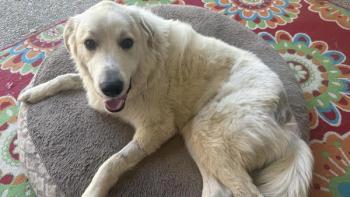
Managing myasthenia gravis (Proceedings)
Acquired myasthenia gravis is an immune-mediated disorder in which autoantibodies develop against the neuromuscular junction acetylcholine receptors (AChR).
Acquired myasthenia gravis
Acquired myasthenia gravis is an immune-mediated disorder in which autoantibodies develop against the neuromuscular junction acetylcholine receptors (AChR). Binding of these antibodies results in failure of neuromuscular transmission. Mechanisms for antibody impairment of neuromuscular transmission is not entirely known, but may involve one or a combination of the following: direct interference and binding of ACh to the receptors, accelerated endocytosis of the crossed-linked receptors, complement-mediated destruction of the post-synaptic muscle cell membrane, and decreased synthesis and incorporation of new receptors into the membrane. The disease is most common in dogs and people. The mean age of dogs affected is 6.65 years, but there appears to be a bimodal age distribution of affected dogs of 3 and 10 years. There is a predilection to affect spayed female dogs. There appears to be a high relative risk in the golden and Labrador retriever, Akita, Miniature Dachshund, Scottish terrier, German shorthaired pointer, Shetland sheepdog, and collie. Dogs less than 1 year of age and intact males appear to have a decreased relative risk for acquiring the disease.
The classical clinical signs have been reported to be exercise-induced weakness followed by resolution at rest. However, these signs appear to be the exception rather than the rule. There are 3 described forms in the dog (Table 1).
Table 1
Myasthenia typically occurs in absence of some underlying disease, but it has been reported in conjunction with thymoma, osteosarcoma, and cholangiocellular carcinoma. MG is the most commonly reported paraneoplastic syndrome associated with thymoma, and MG patients with thymoma may have a higher likelihood to have the acute fulminating form of the disease. The relationship to thymoma is not known, but it is postulated that neoplastic thymic cells express antigenic epitopes similar to NMJ AChR and cytoskeletal proteins of skeletal muscles. The antineoplastic immune response to the epitopes results in high levels of circulating autoantibodies.
It is possible that focal MG may be an earlier manifestation of the generalized form. Although this is true in people, it has not been proven in dogs.
The risk factors for developing the acute fulminating form are not clear. In people with myasthenic crisis, infections (urinary or respiratory) or concurrent illness are found to be risk factors. Dogs typically have concurrent aspiration pneumonia, but it is not known if this is cause or effect. Regurgitation in this form is consistent and severe, and decreased cough reflex may result in "silent" aspiration.
Diagnosis is based on signalment, history, clinical, and laboratory testing. Administration of acetylcholinesterase medication, edrophonium chloride (Tensilon®) can result in rapid improvement in muscle strength and is suggestive for MG. However, false positive tests can occur and true positive tests may be seen in only 50-75% of MG cases. Partial responses are common and there is often a lack of response in cases with the acute fulminating form. Therefore, a negative Tensilon test does not rule out MG. The Tensilon test can still help in determining the potential value of using long acting acetylcholinesterase medications for therapy. Repetitive nerve stimulation reveals a classical response of detrimental amplitude of muscle action potential. However, nerve conduction studies require general anesthesia and this is contraindicated in animals with aspiration pneumonia or acute fulminating disease. The most definitive method of diagnosis is measurement of anti-AChR autoantibodies. The range of titers in affected dogs is reported as 0.74-34.1 nmol/L. Anti-AChR antibody titers are considered positive at levels > 0.6 nmol/L. Animals with the focal form have been reported with titers of 1.05-2.0 nmol/l. The range reported for generalized MG is 1.82-6.4 nmol/L. There is no statistical difference between the titer values for the focal and generalized form. The acute fulminating form of the disease is associated with statistically higher titer values reported as 12.0-34.1 nmol/L.
Treatment involves stabilizing the animal's secondary signs (aspiration pneumonia) and treating the disease. Long-acting acetylcholinesterase, pyridostigmine bromide (Mestinon®), is used for long-term treatment. Knowledge of side effects and recognition of cholinergic crisis is important. Although controversial, immunosuppressive drugs have been associated with improved long term survival in people and a few dogs. The controversy revolves around the use of immunosuppressive drugs in animals that are affected by or have predilection for developing aspiration pneumonia. Corticosteroids (prednisone) and azothioprine use have been reported. An acute worsening of signs after initial administration of immunosuppressive doses of steroids has been seen in people and dogs. In people, lower starting dosages and increase of dosage over 3 days, or every other day administration have decreased the incidence of this problem. Transtracheal wash and culture and sensitivity should be done to diagnose and treat the bacteria involved in aspiration pneumonia. Aminoglycoside antibiotics should be avoided if possible as they can potentiate neuromuscular weakness. Feeding should be elevated or an animal should have a gastric feeding tube placed if regurgitation and aspiration are a problem.
Acute fulminating MG is a critical care crisis. This form of the disease has a high mortality rate with respiratory failure as the most common cause of death. This form of the disease is hard to diagnose initially because titers are not immediately available, the animal should not be anesthetized for nerve stimulation, and they often do not respond to edrophonium administration. These animals should be evaluated for concurrent disorders such as infection, thymoma, organ failure, electrolyte imbalances, and hypothyroidism. Administration of parenteral acetylcholinesterase medications may be required. Plasmapheresis is used in humans to decrease the autoantibody titer, but there are significant side effects associated with this procedure and its efficacy in dogs is not fully known. Control of massive regurgitation is required and can be difficult. Nutritional support is difficult with the consistent regurgitation. Respiratory failure is due to aspiration pneumonia, respiratory muscle weakness, or both. Animals may require ventilatory support. Broad-spectrum antibiotics are needed for aspiration pneumonia. Sepsis and shock are common sequelae to this form of the disease.
The prognosis for the MG is not great but depends on the form and commitment of the client. In one report, 48% of the animals died or were euthanatized due to poor response to therapy. Risk of death or euthanasia is associated with megaesophagus/aspiration pneumonia. Acute fulminating cases often die within 72 hours due to respiratory failure. One year survival for 25 dogs in one study was only 40.4%. Megaesophagus does not always resolve with treatment. Owners must be compliant in medicating and supportive care for megaesophagus (elevated frequent feedings and treating aspiration pneumonia).
Myasthenia gravis is a rare, sporadic disease in cats. The age range is 6 months to 15 years (mean 7.7, median 9 years). MG in cats also has a bimodal age pattern with most cases occurring between 2-3 years and 9-10 years. The disease has been reported in several breeds: D.H., Abyssinian, Somali, Siamese, Manx, Himalayan, and Persian. There may be a predilection in Abyssinian cats. Clinical signs are most frequently weakness and stiff-stilted gait. Duration of signs before presentation is 24 hours to 8 months. The most common owner complaints and clinical exam findings identified in 20 cats with MG are listed in Table 2.
Table 2
Differential diagnoses for cervical ventroflexion in the cat include thiamine deficiency, polymyopathy/neuropathy, hyperthyroidism, organophosphate toxicity, hypokalemia, and hypernatremia. Thymoma has been confirmed in two feline cases and suspected (presence of mediastinal mass) in one case.
Diagnosis is based on serum MG autoantibody titers. Edrophonium chloride IV (0.25-0.5 mg IV in the cat) can induce improvement within 30-60 seconds and lasting 3-5 minutes. Muscarinic signs of overdosage (salivation, lacrimation, urination, and respiratory paralysis) have not been seen at this dosage. In reported cases, the range of positive antibody titers was 0.31-15.5 nM/L (mean 5.4 nm/l). The mean titer for animals without weakness, with appendicular weakness and with acute fulminating disease were 4.3, 10.0, and 19.0 nm/L, respectively.
Treatment with an acetylcholinesterase inhibitor (pyridostigmine bromide) and immunosuppression is recommended. The cat dosage of pyridostigmine bromide is 1.5-2.5 mg PO q12 hours before feeding to ensure absorption. Immunosuppressive therapy can be instituted with dexamethasone, prednisone, or cyclophosphamide. A newer immunosuppressant, mycophenolate (CellCept®), has also been used. However, the cost of this medication can be quite high in a large breed dog. Supportive care for the acutely ill animal is required. Antibiotics may be required if aspiration pneumonia develops. Cimetidine (3.0-7.5 mg/kg q 8 hours) and metoclopramide (0.2-0.4 mg/kg q8 hours) may help with the regurgitating animal. It is recommended that anti-AChR antibody titers be monitored until the animal is in remission and the immunosuppression can be tapered. The need for long-term immunosuppression and/or acetylcholinesterase inhibitors will vary from patient to patient. Dogs may continue to have some clinical signs after the antibody titer has dropped, but this is frequently related to megaesophagus. If AChR receptor antibody titers return to normal range, periodic testing may be inidicated.
The prognosis of this disease in cats is variable. The focal form occurs less commonly in cats than dogs. In general, cats may have a better prognosis than dogs with a 1 year survival rate 55% higher than dogs. However, there have been relatively few numbers of reported cases. There is decreased incidence of esophageal dysfunction in cats (60%) compared to dogs (84%). This may be due to decreased density of skeletal muscle in the cat esophagus.
Congenital myasthenia gravis
A different form of myasthenia gravis occurs with congenital incidence. The disease has found to be autosomal recessive in Jack Russell terriers, Smooth fox terriers, English springer spaniels. Often several puppies in a litter are affected. The disease has also been reported in the domestic short-hair cat and Siamese (congenital, 4-5 months of age), a Samoyed and the Gammel Dansk honsehund. Failure of neuromuscular transmission occurs not from antibodies directed against the AchR, but due to a deficiency in the muscle's concentration of receptors on the post-synaptic membrane. In studies, receptor density is 25% or less of normal dogs. It has been determined that this deficiency is not related to an inability of the muscle to synthesize the receptor or an increase in degradation of the receptor. There appears to be a low insertion rate of the receptor into the post-synaptic membrane suggesting that there is dysfunction in a post-translational processing step of receptor generation.
At birth, strength and body weight are normal. Clinical signs usually begin around 5-8 weeks of age and are progressive. Initially, the animal develops a stiff pelvic limb gait and fatigability with walking and running. The intermittent progressive muscle weakness becomes more pronounced with exercise. Muscle wasting, megaesophagus, and aspiration pneumonia can develop. Later the animal loses the ability to raise the head and uses the head as a lever about which to move. Dysphagia, pseudoptyalism, and inability to close the mouth are common signs. Signs progress relentlessly until about 30 weeks, at which time they may become stable. However, the animal usually can not ambulate or hold up its head.
Intravenous edrophonium chloride can aid in a presumptive diagnosis. Because the defect is a result of decreased receptors, measurement of autoantibodies against ACh receptors is not a valuable test. Biopsy reveals a significantly decreased number of receptors. Response to long-term treatment of pyridostigmine bromide is variable. Cholinergic crises can occur.
Prognosis is generally considered poor but there are a few cases reported which have had adequate quality of life. Cats may have a better long-term prognosis.
Newsletter
From exam room tips to practice management insights, get trusted veterinary news delivered straight to your inbox—subscribe to dvm360.






